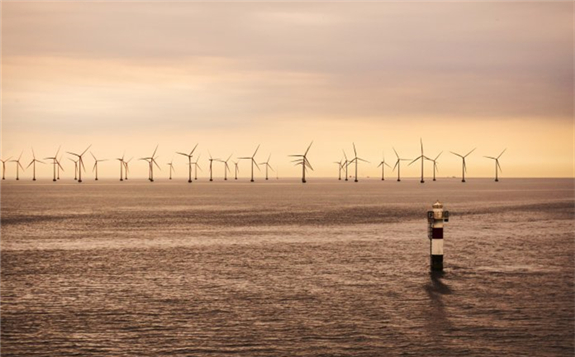
The news was heralded by environmentalists as an important step in the state’s transition away from fossil fuels, one in line with Gov. Ralph Northam’s recent executive order pledging that Virginia’s electric grid would be carbon free by 2050.
But many question marks remain around the three-phase project, which Dominion says will be complete by 2026 and will cost an estimated $7.8 billion. Here’s four key things to know about the current state of wind energy in Virginia, what and how offshore wind is being developed elsewhere and what comes next.
1. Virginia has pledged to make its electric grid carbon free by 2050. But the state currently has no wind energy in its portfolio.
When it comes to words, Virginia has made a strong commitment to wind energy. The sweeping 2018 Grid Transformation and Security Act declared the development of 5,000 megawatts of solar and wind energy to be “in the public interest,” and Virginia’s 2018 Energy Plan recommended that Northam set a goal of developing 2,000 megawatts of offshore wind by 2028. Northam’s Executive Order 43, which committed the state to a carbon-free grid by 2050, increased that goal to 2,500 megawatts of offshore resources and set a new deadline for its development of 2026.
Those are ambitious targets, particularly considering that as of July 2019, Virginia’s wind assets — offshore and onshore — amounted to zero.
According to the American Wind Energy Association, Virginia is one of only nine states in the country that has no operating wind energy projects. The others are Kentucky, Arkansas, Louisiana, Mississippi, Alabama, Georgia, Florida and South Carolina.
2. Dominion’s 220-turbine project, which could be the largest offshore wind farm in the world when complete, is one of a spate of major offshore wind proposals announced this summer on the East Coast.
Compared to European nations, the U.S. has lagged in developing offshore wind. In 2018, offshore wind farms in the Atlantic were producing a staggering 18,500 megawatts of power for 11 European states, according to wind energy advocacy group WindEurope. The U.S. total: 30 megawatts, all of it from the Block Island Wind Farm off the coast of Rhode Island.
The largest offshore wind farm in the world is also found across the pond. Hornsea One is the first phase of a project in the North Sea that is expected to produce 1,200 megawatts of energy for the United Kingdom by 2020. The project’s third phase — called, you guessed it, Hornsea Three — will generate double that.
But with anxieties about climate change spiking, wind developers are seeing a widening array of opportunities along the U.S. East Coast, where the continental shelf makes waters shallow enough to allow turbines to be driven into the ocean floor.
This summer saw a string of wind farm announcements by New England and mid-Atlantic states, each promising to generate ever more energy: 700 megawatts for Rhode Island’s Revolution Wind in May, 1,100 for New Jersey’s Ocean Wind in June and 1,700 for New York’s combined Sunrise Wind and Empire Wind in July. Dominion’s 2,600 megawatt reveal was the cherry on top.
3. In other states, development is largely driven by private companies, not publicly regulated utilities. But in Virginia, Dominion is taking the reins.
Of the 15 leases granted by the U.S. Bureau of Ocean Energy Management to develop offshore areas for energy production as of August 2019, all except one have gone to private developers, which have then contracted with state utilities to feed their energy into the grid.
In Virginia, however, Dominion Energy has been responsible for all offshore wind development. The state’s largest utility (operating as Virginia Electric Power Company) holds the lease to almost 113,000 acres of offshore property slated for wind energy generation and since 2013 has been working with the state on a 12-megawatt offshore wind pilot project, which broke ground this July. Danish wind energy giant Ørsted, which is behind the Ocean Wind, Revolution Wind and Sunrise Wind projects, is acting as the project’s primary contractor.
Dominion’s go-it-alone approach has garnered criticism from state regulators, who have noted that while other utilities that have added offshore wind to their portfolio have relied on power purchase agreements with developers, who then assume most of a project’s risks, Dominion’s decision to construct wind farms itself “places essentially all the risk on Dominion’s customers.”
4. Dominion still has a long list of regulatory hoops to jump through before the project can move forward.
Lost in much of the excitement over Dominion’s plans last week was the fact that the company’s announcement was a notification of intent, not approval. While Dominion stated that it had submitted an application to connect the proposed turbines to the PJM transmission grid, from which Virginia, as well as 12 other states and Washington, D.C. gets its energy, a spokesman for PJM said that any plans were still confidential.
Dominion will need more than a thumbs up from PJM. It will also need more approvals from the U.S. Bureau of Ocean Energy Management and the Virginia State Corporation Commission, among other agencies. The latter will need to issue the utility a certificate to construct and operate a generating facility and, depending on how Dominion decides to fund the project, might also need to okay a rate rider, a charge tacked onto customers’ bills to pay for a specific initiative.
The commission has made clear its disapproval of Dominion’s pilot offshore wind project, declaring that “as a purely factual matter” it couldn’t describe the utility’s plans as “prudent.” But because the General Assembly has identified the development of wind energy as a state priority, the commission seems unlikely to deny the company a requested certificate.